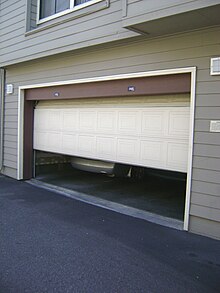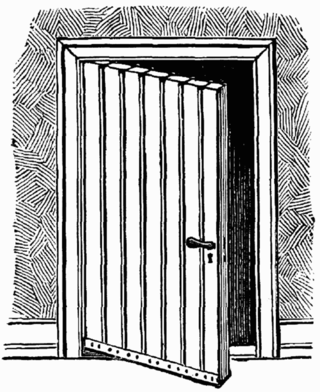
A door is a hinged or otherwise movable barrier that allows ingress (entry) into and egress (exit) from an enclosure. The created opening in the wall is a doorway or portal. A door's essential and primary purpose is to provide security by controlling access to the doorway (portal). Conventionally, it is a panel that fits into the doorway of a building, room, or vehicle. Doors are generally made of a material suited to the door's task. They are commonly attached by hinges, but can move by other means, such as slides or counterbalancing.
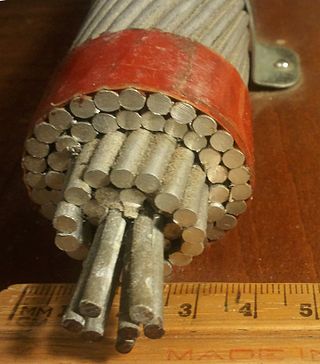
A wire is a flexible, round, bar of metal.

The hood or bonnet is the hinged cover over the engine of motor vehicles. Hoods can open to allow access to the engine compartment, or trunk on rear-engine and some mid-engine vehicles) for maintenance and repair.

A structural insulated panel, or structural insulating panel, (SIP), is a form of sandwich panel used in the construction industry.
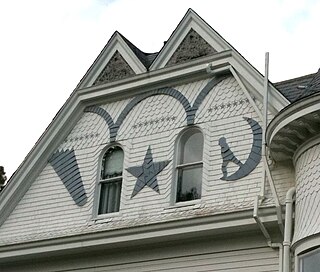
Siding or wall cladding is the protective material attached to the exterior side of a wall of a house or other building. Along with the roof, it forms the first line of defense against the elements, most importantly sun, rain/snow, heat and cold, thus creating a stable, more comfortable environment on the interior side. The siding material and style also can enhance or detract from the building's beauty. There is a wide and expanding variety of materials to side with, both natural and artificial, each with its own benefits and drawbacks. Masonry walls as such do not require siding, but any wall can be sided. Walls that are internally framed, whether with wood, or steel I-beams, however, must always be sided.

A curtain wall is an exterior covering of a building in which the outer walls are non-structural, instead serving to protect the interior of the building from the elements. Because the curtain wall façade carries no structural load beyond its own dead load weight, it can be made of lightweight materials. The wall transfers lateral wind loads upon it to the main building structure through connections at floors or columns of the building.

Electrical wiring is an electrical installation of cabling and associated devices such as switches, distribution boards, sockets, and light fittings in a structure.

A garage door opener is a motorized device that opens and closes a garage door controlled by switches on the garage wall. Most also include a handheld radio remote control carried by the owner, which can be used to open and close the door from a short distance.

A power cable is an electrical cable, an assembly of one or more electrical conductors, usually held together with an overall sheath. The assembly is used for transmission of electrical power. Power cables may be installed as permanent wiring within buildings, buried in the ground, run overhead, or exposed. Power cables that are bundled inside thermoplastic sheathing and that are intended to be run inside a building are known as NM-B.

Insulating concrete form or insulated concrete form (ICF) is a system of formwork for reinforced concrete usually made with a rigid thermal insulation that stays in place as a permanent interior and exterior substrate for walls, floors, and roofs. The forms are interlocking modular units that are dry-stacked and filled with concrete. The units lock together somewhat like Lego bricks and create a form for the structural walls or floors of a building. ICF construction has become commonplace for both low rise commercial and high performance residential construction as more stringent energy efficiency and natural disaster resistant building codes are adopted.

A window shutter is a solid and stable window covering usually consisting of a frame of vertical stiles and horizontal rails. Set within this frame can be louvers, solid panels, fabric, glass and almost any other item that can be mounted within a frame. Shutters may be employed for a variety of reasons, including controlling the amount of sunlight that enters a room, to provide privacy, security, to protect against weather or unwanted intrusion or damage and to enhance the aesthetics of a building.

A window screen is designed to cover the opening of a window. It is usually a mesh made of metal, fibreglass, plastic wire, or other pieces of plastic and stretched in a frame of wood or metal. It serves to keep leaves, debris, bugs, birds, and other animals from entering a building or a screened structure such as a porch, without blocking fresh air-flow.

Ducts are conduits or passages used in heating, ventilation, and air conditioning (HVAC) to deliver and remove air. The needed airflows include, for example, supply air, return air, and exhaust air. Ducts commonly also deliver ventilation air as part of the supply air. As such, air ducts are one method of ensuring acceptable indoor air quality as well as thermal comfort.

A screen door can refer to a hinged storm door or hinged screen door covering an exterior door, or a screened sliding door used with sliding glass doors. A screen door incorporates screen mesh to block birds, flying insects or airborne debris such as seeds or leaves from entering, and pets and small children from exiting interior spaces, while allowing for air, light, and views.

Building insulation materials are the building materials that form the thermal envelope of a building or otherwise reduce heat transfer.

High-speed doors are door systems, mainly used in industrial applications. They are technical enhancements of the generally known sectional doors, PVC fabric doors or roller shutters. The main difference is that the durable construction provides a higher operating speed and they are able to sustain a higher number of cycles and require lower maintenance and repair cost. Depending on the intended field of application, horizontal or vertical operating door types are available.
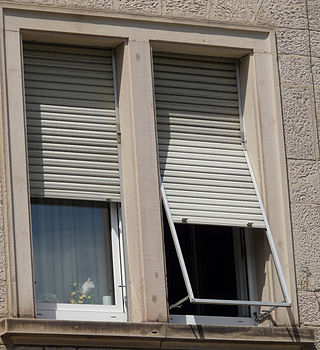
A roller shutter, security shutter, coiling door, roller door or sectional overhead door is a specialized type of door or window shutter consisting of multiple horizontal slats, bars, or web systems interconnected through hinges. The mechanism involves lifting the door to open it and lowering it to close. In the case of larger doors, an automated, motorized system may be employed.

A drum motor is a geared motor drive enclosed within a steel shell providing a single component driving pulley for conveyor belts.

The Frantz Manufacturing Company located in Sterling, Illinois, is a manufacturer and marketer of conveyor system components and steel ball products used in a variety of applications.

The Little Harbor 44 is an American sailboat that was designed by Ted Hood and first built in 1983.
